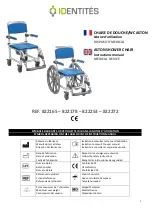
25
SAFETY TIPS
Important Information
The EMI value of this device was tested to 20 volts per meter (V/m), although if any
accessories are added the immunity level is unknown. (EUT tested February 2001)
CAUTION
IT IS VERY IMPORTANT THAT YOU READ THIS INFORMATION
REGARDING THE POSSIBLE EFFECTS OF ELECTROMAGNETIC
INTERFERENCE ON YOUR POWERED WHEELCHAIR.
Electromagnetic Interference (EMI) From Radio Wave Sources
Powered wheelchairs may be susceptible to electromagnetic interference (EMI), which is
interfering electromagnetic energy (EMI) emitted from sources such as radio stations, TV
stations, amateur radio (HAM) transmitters, two-way radios, and cellular phones. The
interference (from radio wave sources) can cause the powered wheelchair to release its
brakes, move by itself, or move in unintended directions. It can also permanently damage the
powered wheelchair’s control system. The intensity of the interfering EMI energy can be
measured in volts per meter (V/m). Each powered wheelchair can resist EMI up to a certain
intensity. This is called its “immunity level”. The higher the immunity level, the greater the
protection. At this time, current technology is capable of achieving at least a 20 V/m immunity
level, which would provide useful protection from the more common sources of radiated EMI.
This powered wheelchair model as shipped, with no further modification. The immunity level of
this product is not known.
There are a number of sources of relatively intense electromagnetic fields in the everyday
environment. Some of these sources are obvious and easy to avoid. Others are not apparent
and exposure is unavoidable. However, we believe that by following the warnings listed below,
your risk to EMI will be minimized. The sources of radiated EMI can be broadly classified into
three types:
1. Hand-held portable transceivers (transmitters-receivers) with the antenna mounted directly
on the transmitting unit. Examples include citizens band (CB) radios, “walkie talkies”,
security, fire, and police transceivers, cellular telephones and other personal
communication devices.
NOTE: Some cellular telephones and similar devices transmit signals while they are ON,
even when not being used.
2. Medium-range mobile transceivers, such as those used in police cars, fire trucks,
ambulances, and taxis. These usually have the antenna mounted on the outside of the
vehicle.
3. Long-range transmitters and transceivers, such as commercial broadcast transmitters
(radio and TV broadcast antenna towers) and amateur (HAM) radios.
NOTE: Other types of hand-held devices, such as cordless phones, laptop computers,
AM/FM radios, TV sets, CD players and cassette players, and small appliances, such as
electric shavers and hair dryers, so far as we know, are not likely to cause EMI problems to
your powered wheelchair.
Summary of Contents for Overlander PEV
Page 2: ......
Page 35: ......
Page 36: ...www wheelchairsofkansas com 800 537 6454 785 726 4885 ...








































